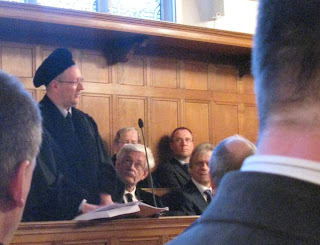A few days ago, I attended a meeting in Gothenburg, Sweden, on furthering the work to set up the Artistic Research Catalog, an on-line workspace that aims at developing a high standard of referencing, storing and documenting artistic research projects.
The core forces behind this project are the Bern and The Hague Universities of the Arts, supported by a host of institutions from The Netherlands, Britain, Switzerland, Germany, the US and pan-European consortia such as the European Association of Conservatories, the European Society for Literature, Science and the Arts, and the European League of Institutes of the Arts.
Several meetings with many individuals representing these institutions are set up to gage the needs of the generic artistic researcher in order to develop the software that would attain the sought after standard. As most of the members of this project are from the visual arts sector (including representation of the art of design, of architecture and of some interdisciplinary orientations), with Dutch improviser Peter van Bergen, Flemish composer Paul Craenen and me representing music, there is a distinct gravitational force weighing in on the exchange of ideas. The imbalance has not only its effect on the topics of the discussions but on the terminology as well (‘exposition’ / ‘works’), and hence on the concepts with which the software developers will work. It remains to be seen how efficient it will be to insist on merging audio and visual culture in such an enterprise. The problem is of course inherently linked to the notion that ARC wants to be a bottom-up enterprise, interested in learning from existing artistic research projects to know what researchers and artists require for the storage and publication of their work. Apart from the ongoing or unsettled debate on what constitutes artistic research in music, making it difficult to know the wishes of the generic researcher, there are many less artistic researchers in music than in the visual arts, where the notion has been entertained more widely and for a longer period already.
Fortunately, it has been decided that a prototype of the software will be available soon for the members of this initial phase to work with and learn from. That should speed things up, so I am looking forward to seeing what is possible and what is lacking. Only then will we find out what we want this catalog to do for us.
The software is meant to be open source so that other initiatives can use it as well. If the idea of more than one such catalog based on this software is still not more than a concept, one project is being developed to use this digital ARC platform as we speak: the Journal for Artistic Research. More on JAR can be read here. The first issue is planned for publication in the coming months – it is said to be a ‘zero-issue’, probably meaning that the double-blind peer review standard will be used from the next issue onwards. The publisher of JAR is the Society for Artistic Research, of which a little information is to be read here.
As much as SAR would seem to be fundamental to both the other enterprises, it appears to be least active and only be called into existence to work out JAR, which in turn needs ARC to function. As ARC is a two-year project (at least if the supporting grant is not renewed or replaced with alternate financing) already in the beginning of its second year, it is not clear how and by whom the catalog will be exploited as an independent workspace for researchers once it is up and running. For the time being, it looks like JAR is the real aim of the community that called it into life. As for SAR, there is much potential still to be tapped. If the number of artistic researchers is still small, it feels great enough to start acting like a society, exploring its critical mass far beyond creating a channel to disseminate its findings. But the impetus is there and soon the first exploits will make history.












